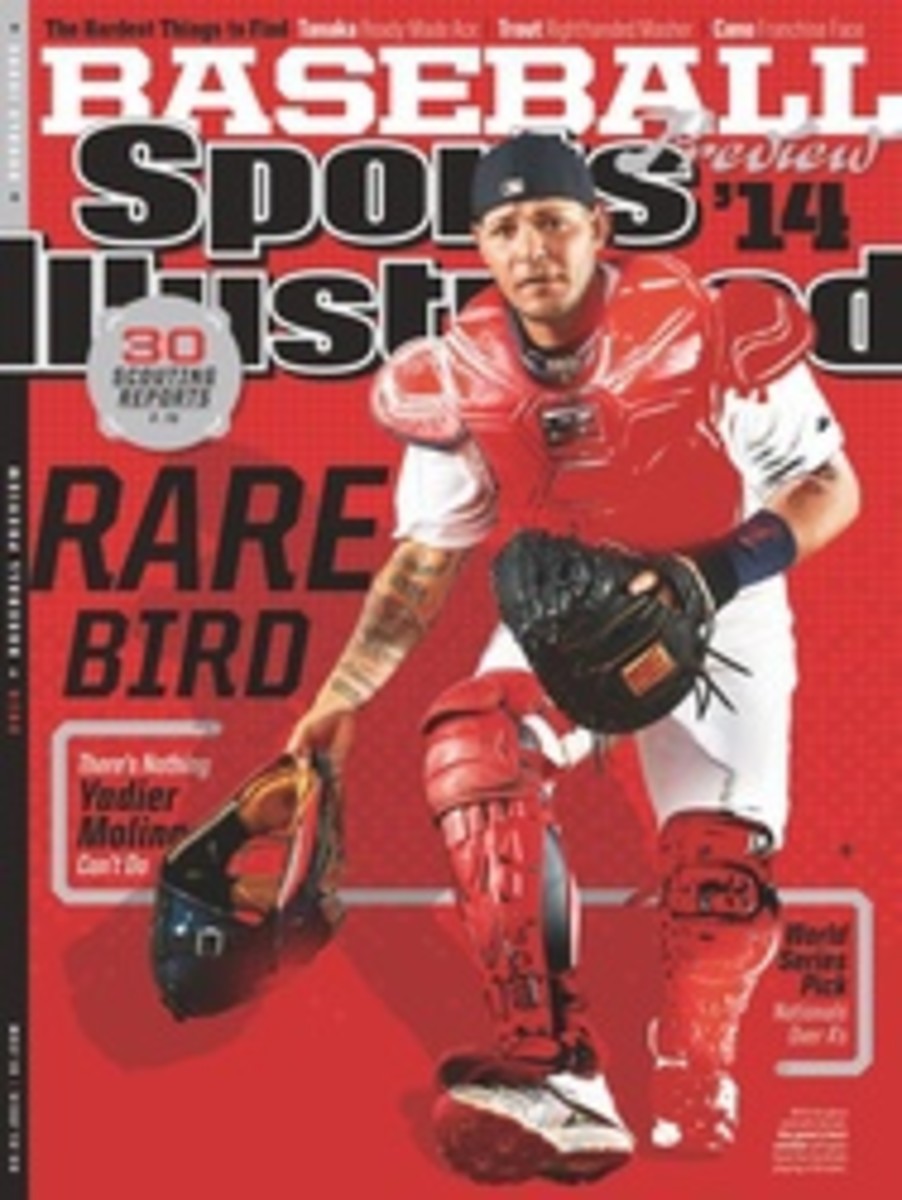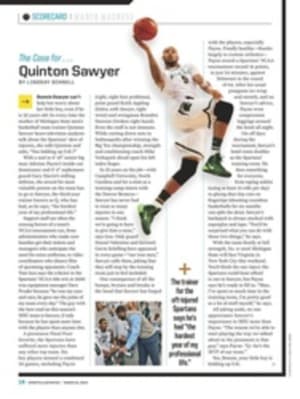
Béisbol Prospectus
In Cuba, the game has traditionally been felt, not analyzed. But a guerilla group of homegrown sabermetricians is bringing science to the nation's sports obsession
Hard to Find
IT'S SATURDAY NIGHT in Havana's historic Estadio Latinoamericano. Bottom of the 12th inning of the second game of a doubleheader. The hometown Industriales and Holguín are fighting for the fourth and final playoff spot in Cuba's Serie Nacional.
Everyone still in the park—fan, player, coach, food vendor—is worn down to raw nerve. This game has seen a pivotal interference call, a runner thrown out at home and another doubled off second after tagging up early. Down 5--3 in the bottom of the eighth, the Industriales took a 6--5 lead, which they blew in the ninth.
Alejandro Aldama, 25, clings to a few rolled-up sheets of computer paper like they are a map to hidden treasure. He paces in the underground section of stands behind home plate. Watching the game from here, sunk below the infield grass, is like watching from a foxhole.
Aldama is cofounder and vice president of the Independent Group for Baseball Investigation (GIIB), Cuba's first official sabermetric organization. The treasure map in his hand actually contains rosters and advanced stats. This year the GIIB is working with Industriales manager Làzaro Vargas, providing advanced statistical analysis, a first in Cuba for any team.
Four glaring light towers lean forward over the empty outfield bleachers and shine on Industriales outfielder Stayler Hernandez, who walks to the plate flirting with a .200 average. The fans above him whistle and blow noisemakers. Aldama wipes sweat from his brow. Vargas sits comfortably in the dugout as Hernandez settles into the lefthanded batter's box.
SABERMETRICS—THE ADVANCED, computerized and occasionally counterintuitive analysis of baseball statistics—is beginning to take hold in Cuba. Television and radio commentators on the island are introducing new stats such as BABIP and WAR to their broadcasts. And like their American counterparts, many Cuban fans were introduced to sabermetrics by the film version of Michael Lewis's Moneyball.
But information remains hard to come by in Cuba, and slow to spread. Serie Nacional teams don't have massive budgets or unlimited front-office resources. Fans are not equipped with computers and access to the Internet. And although major league teams view Cuba as a talent pipeline, Cuba itself is not hung up on the American conception of baseball. Players who play beautifully and rise to grand occasions are called guapo, or handsome, brave. In Cuba baseball is like art or love or faith—meant to be felt as much as understood.
To the 17 full-fledged members of the GIIB, the feeling and understanding of baseball are inseparable from one another. They're intellectuals, empiricists, the kind of guys who believe that the best way to express your love of something is to spend years studying and arguing about it. They talk about sabermetrics in the context of classic economists: "Marx's economic theories are basically sabermetrics," says Aldama. "It's the elimination of subjectivity." But before they organized into a formal group, they were just buddies—philosophers, engineers, computer scientists centered around the University of Havana—with a shared passion for baseball.
The GIIB grew out of the childhood friendship between Aldama, a physical-education student, and Camilo Quintas, a computer science student who serves as president. Aldama and Quintas would spend hours playing the video game Triple Play Baseball on Quintas's mom's work computer. The game featured a stat they had never heard of called OBP. Nobody they asked knew what it stood for. They finally figured it out for themselves and, hooked, spent years studying statistics, obsessed with finding ways to more accurately measure what happened on a baseball field. One day in 2005, Aldama and Quintas negotiated a few hours of Internet access. There, before their eyes, was sabermetrics. They discovered thinkers like Bill James and Tom Tango. Suddenly they were not alone.
The friends gathered all the literature they could, passing around articles and copies of Moneyball (read slowly, in English). But soon, in part due to their relative isolation, they began to think more freely and separate themselves from what they refer to as "traditional sabermetrics." They created statistics such as gERA, a measure of pitching effectiveness that they believe improves on the sabermetric mainstay FIP (Fielding Independent Pitching) by taking into account different kinds of contact. They developed their own algorithmic software program called Strike, a database that self-generates advanced stats.
"A lot of people think the 'independent' in our name only exists to separate us from national politics, but it goes far beyond that," said Aldama. "It's that we're independent technologically."
They are also independent ideologically. That means challenging the establishment—including Tango, their favorite sabermetrician—and tailoring their research to the specifics of the Cuban game. For example, the GIIB believes that the greatest blind spot in American sabermetrics is the tendency to ascribe success in short, high-pressure series to luck. They talk relentlessly about the importance of predicting success in what they call, in English, "clutchtime." Aldama says the group has extensive research that it isn't quite ready to share.
Says Luis Quesada, the group's resident philosopher, "We want to carry out research based on our experience, our culture, our way of watching baseball."
INDUSTRIALES MANAGER VARGAS understands the Cuban way of watching and playing baseball. He was a star third baseman with the Industriales and won two Olympic gold medals with the national team. But Vargas, a sturdy 50-year-old with a shaved head and an easygoing manner, is also aware of—and open to—the things he doesn't understand.
When the GIIB offered their services to the Industriales before the season, Vargas looked over their work and accepted on the spot. He was not the only Serie Nacional manager the group approached, but he was the only one willing to listen. He had been interested in numbers since his playing days, and he had been keeping an eye on sabermetrics.
Vargas believes sabermetrics will catch on in Cuba. The GIIB gives occasional courses, and MLB broadcasts have become increasingly available thanks to illegal satellite dishes. But for now too many baseball people on the island think they already know everything about the game. There is a sabermetric generation gap. "How can you turn your back on facts?" Vargas says. "How can you turn your back on science?"
Vargas consults with GIIB members regularly and keeps a stat sheet they provide in the dugout. He credits sabermetrics with giving him a better understanding of his players' strengths and weaknesses, helping him construct smarter lineups and make better-informed substitutions late in games. The jewel of Vargas's lineup is Yulieski Gourriel, a 29-year-old third baseman with an easy swing and a stellar glove. He has expressed a desire to play in the major leagues, and the GIIB guys rate him as the best player on the island—even if he grades as a poor performer in clutchtime.
Aldama, Quintas and the GIIB, meanwhile, get to see their work applied on the field: the place where percentages run up against human frailty.
"They've taught me some things with their numbers, and I've taught them that numbers can sometimes fail," says Vargas.
TWELFTH INNING. Six to six. This is as clutchtime as it gets. Stayler Hernandez steps into the box for the 2--1 pitch and drives it hard into the starry Havana night. The ball game is over before it lands.
Aldama leaps, shouts and hugs everyone around him, the stat sheets tight in his fist. As Hernandez circles the bases and the ball clanks harmlessly around the bleachers in right center, Aldama steps out onto the field to celebrate alongside the Industriales. He greets Hernandez and Vargas.
A couple of days later, in his office under the first base seats, Vargas will grin while going over a few of the decisions he made in the late innings. A choice based on a statistical matchup he liked led to a run-scoring single, and that player then scored. A numerically influenced pitching change led to an inning-ending double play.
"That," he said, "was all sabermetrics."
"Marx's economic theories are basically sabermetrics," says the GIIB's cofounder.
Next Up?
Who might major league talent evaluators be eyeing in Cuba? With a month left in Serie Nacional, the country's top league, here is the GIIB's ranking of this season's top five offensive players as rated by gWAR, a proprietary measure of player value similar to Wins Above Replacement, and the best pitchers according to gERA, or defense-adjusted ERA.
CUBA'S TOP POSITION PLAYERS
GERA | |
1. VLADIMIR GARCIA | 2.25 |
2. YOSVANI TORRES | 2.62 |
3. ISMEL JIMENEZ | 2.66 |
4. FREDDY ASIEL | 2.72 |
5. NORGE LUIS RUIZ LOYOLA | 2.87 |
PHOTO
ROBIN VAN LONKHUIJSEN/EPA/LANDOV
A HERO TO BOTH SCHOOLS The smooth Gourriel, a fan favorite in Cuba, is also rated highly by the island's statheads.
PHOTO ILLUSTRATION
PHOTO ILLUSTRATION BY STEPHEN SKALOCKY
KOICHI KAMOSHIDA/JANA PRESS/ZUMAPRESS.COM (CEPEDA)
Frederich Cepeda
PHOTO ILLUSTRATION
PHOTO ILLUSTRATION BY STEPHEN SKALOCKY
TORU HANAI/REUTERS (GARCIA)
Vladimir Garcia

